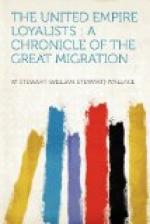Had more use been made of the Tories, the military history of the Revolution might have been very different. They understood the conditions of warfare in the New World much better than the British regulars or the German mercenaries. Had the advice of prominent Loyalists been accepted by the British commander at the battle of Bunker’s Hill, it is highly probable that there would have been none of that carnage in the British ranks which made of the victory a virtual defeat. It was said that Burgoyne’s early successes were largely due to the skill with which he used his Loyalist auxiliaries. And in the latter part of the war, it must be confessed that the successes of the Loyalist troops far outshone those of the British regulars. In the Carolinas Tarleton’s Loyal Cavalry swept everything before them, until their defeat at the Cowpens by Daniel Morgan. In southern New York Governor Tryon’s levies carried fire and sword up the Hudson, into ’Indigo Connecticut,’ and over into New Jersey. Along the northern frontier, the Loyalist forces commanded by Sir John Johnson and Colonel Butler made repeated incursions into the Mohawk, Schoharie, and Wyoming valleys and, in each case, after leaving a trail of desolation behind them, they withdrew to the Canadian border in good order. The trouble was that, owing to the stupidity and incapacity of Lord George Germain, the British minister who was more than any other man responsible for the misconduct of the American War, these expeditions were not made part of a properly concerted plan; and so they sank into the category of isolated raids.
From the point of view of Canadian history, the most interesting of these expeditions were those conducted by Sir John Johnson and Colonel Butler. They were carried on with the Canadian border as their base-line. It was by the men who were engaged in them that Upper Canada was at first largely settled; and for a century and a quarter there have been levelled against these men by American and even by English writers charges of barbarism and inhumanity about which Canadians in particular are interested to know the truth.
Most of Johnson’s and Butler’s men came from central or northern New York. To explain how this came about it is necessary to make an excursion into previous history. In 1738 there had come out to America a young Irishman of good family named William Johnson. The famous naval hero, Sir Peter Warren, who was an uncle of Johnson, had large tracts of land in the Mohawk valley, in northern New York. These estates he employed his nephew in administering; and, when he died, he bequeathed them to him. In the meantime William Johnson had begun to improve his opportunities. He had built up a prosperous trade with the Indians; he had learned their language and studied their ways; and he had gained such an ascendancy over them that he came to be known as ‘the Indian-tamer,’ and was appointed the British superintendent-general for Indian Affairs. In




